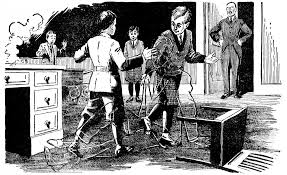“The Plattner Story”, written by the English author H. G. Wells (1866–1946), was first published in the April 1896 edition of the New Review and subsequently reprinted in The Plattner Story and OthersCollection of 17 short stories by H. G. Wells, first published in 1897. (1897) and The Country of the Blind and Other StoriesCollection of 33 short stories by H. G. Wells, first published in 1911. (1911). It concerns a school teacher who causes an explosion during a chemistry experiment, which propels him into another world.[1]
Synopsis
The story is told by an unnamed narrator, who begins by describing a teacher at a small school in the south of England, Gottfried Plattner, all of whose organs and features have been transposed from right to left and vice versa; his heart is on the right side of his body for instance, and the symmetry of his facial features is the opposite of what it appears to be in old photographs The narrator suggests that this proves that Plattner “has moved out of our space into what is called the Fourth Dimension”.
One of Plattner’s duties is to teach chemistry, something he knows very little about having been trained in modern languages. One day a pupil brings in a bottle of some unidentified green powder he had found in a disused limekiln, and Plattner attempts to analyse it, finally deciding to apply a match to a substantial quantity of the powder, causing it to explode. None of the boys in the classroom is hurt, but their teacher has disappeared. At first Plattner believes that he is still in the classroom, but everything seems dark and faint, with only “dim, uncertain, grey shapes [of the classroom] around him. Then two of the boys walk straight through him, persuading Plattner that he must be dead, but then he wonders if it is the boys who are dead and he alone has survived the explosion.
Exploring the environment around him, Plattner finds himself on a rocky hillside, under a green sky, with the bottle of green powder still in his hand. Below him, he can see a number of “pallid, rounded pale-green figures emerging from a mausoleum-like building. Limbless, they drift towards him, human heads above tadpole-like bodies, but they seem to be unaware of him. Still faintly seeing the “real” world superimposed on this “Other-World”, Plattner notices that “to almost every human being in our world there pertained some of these drifting heads; that everyone in the world is watched intermittently by these helpless disembodiments”. The narrator calls them Watchers of the Living. “It may be … that, when our life has closed, when evil or good is no longer a choice for us, we may still have to witness the working out of the train of consequences we have laid.”
Plattner notices a room in a street near the school, where a dying man lies in bed; a woman in the room is looking for a document. Many Watchers of the Living, who seem to know the woman, are witnessing the event. When the woman finds what she seeks, perhaps a will, she burns it in the flame of a candle, while a shadowy arm stretches across to the man in the bed. Not daring to see the shadow behind the arm, Plattner runs and falls, smashing the bottle of green powder, which explodes; and so he returns to his former world nine days after he left it.
The narrator later finds that there was a death in a street near the school at the time of Plattner’s return. The widow, much younger than the deceased, soon married again. The narrator interviews her; although she contradicts Plattner’s account of events during her husband’s last moments, Plattner’s description of the room is “curiously accurate”.
Commentary
The concept of a fourth dimension was popularised by the mathematician and writer Charles Howard Hinton in his 1880 essay “What is the Fourth Dimension?” Today the fourth dimension is commonly regarded as time, as in Albert Einstein’s idea of spacetime, but here it is treated as a further spatial dimension.[2]
The description of the Watchers, with their human heads and tadpole-like bodies, is very similar to that of the Martians in Wells’s 1898 novel The War of the Worlds.[3]
See also
- H. G. Wells bibliographyList of publications written by H. G. Wells during the more than fifty years of his literary career.
External links
- Full text of “The Plattner Story” at Project Gutenberg

